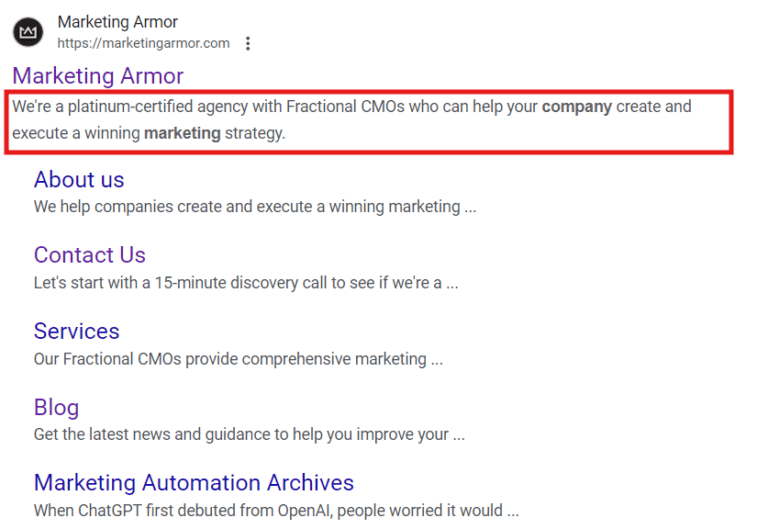Meta descriptions are snippets of text that can influence how your website performs for search engine results pages (SERPs), as well as overall user engagement. But they’re also one of those aspects to website development that can be easy to overlook. Here’s why they’re important to your digital marketing, and the tips you can follow to use them effectively.
What Are Meta Descriptions?
Meta descriptions are HTML attributes that provide brief summaries of web pages. They appear beneath the title tag in SERPs and serve as a preview of the content on the page.
For example, if you happen to type “Marketing Armor” into Google and come across our homepage, the text beneath our name (displayed below) is the meta description that explains who we are and what we offer.

Generally speaking, a meta description is between 150 and 160 characters in length, and should address a page’s content in a way that encourages users to click through.
The Importance of Meta Descriptions in Digital Marketing
Meta descriptions benefit your digital marketing in a number of ways.
1. Search Engine Optimization (SEO)
While meta descriptions arguably aren’t a direct ranking factor for search engines like Google, they can still benefit your SEO. A well-crafted meta description can improve the click-through rate (CTR) of your webpage if people find your explanations interesting enough to read more. Increased CTR will tell search engines that your page is a source of value, which in turn has a positive influence on your website’s ability to rank.
2. First Impressions
Meta descriptions serve as the first impressions for your content because they give users a snapshot of what to expect on each page. Because ranking high on search results can be so competitive, drafting compelling meta descriptions can help you stand out and prompt users to learn more about you before checking out your competitors.
3. Improved User Experience
Clear and concise meta descriptions contribute to better user experiences by accurately representing the content of your pages. They can also lead to lower bounce rates — in other words, having fewer people leave your website without having taken any sort of action like clicking on a link.
4. Enhanced Social Sharing
When pieces of content are shared on social media platforms like LinkedIn and Facebook, their meta descriptions will often appear as preview snippets. Those that are well-written can enhance the appeal of that content, encourage users to click and share, and ultimately drive greater traffic to your site.
Tips for Drafting Effective Meta Descriptions
Now that you know why they’re important, let’s talk about how to apply these descriptions to your website and its landing pages.
1. Keep Them Concise
Search engines typically truncate meta descriptions (indicated by ellipses) once they go over 160 characters. As mentioned earlier, you’ll want to aim for 150 to 160 characters to ensure your entire description is visible.
2. Include Keywords
Incorporate relevant keywords naturally within your meta descriptions. While they won’t be your primary ranking factor, they will be highlighted in SERPs when they match what users have typed in their search requests, making those users more likely to click through and investigate.
It’s good practice to avoid keyword stuffing (the act of intentionally overusing a keyword) which can make your descriptions look spammy and off-putting to potential website visitors.
3. Write Compelling Copy
Use persuasive and engaging language to entice users to click on your links. Highlight the benefits or unique aspects of your content. Think of your meta descriptions as advertisements for your pages — what makes them worth viewing?
When appropriate, use calls to action like “Discover how,” “Learn why,” or “Find out” to make your descriptions more compelling.
4. Be Clear and Specific
Your meta descriptions should clearly convey what users can expect to find on your pages. Avoid vague descriptions that provide neither value nor resolution to what users are searching for. When you’re specific, users are more likely to click.
5. Match User Intent
Understanding and matching user intent is crucial for effective meta descriptions. Analyze what your target audience is looking for and tailor your meta descriptions to meet those needs.
6. Reflect the Content
Ensure that your descriptions accurately represent the content of your pages. Similar to keyword stuffing, misleading descriptions can lead to high bounce rates and a loss of trust from your audience.
Being transparent will build your credibility and encourage users to explore more of your content.
7. Avoid Duplicate Descriptions
Each page on your website should have a unique meta description. Duplicate descriptions can confuse search engines and users, making it harder for them to determine the relevance of your content. Unique meta descriptions help search engines index your pages accurately and provide users with distinct previews for them.
8. Use Schema Markups
A schema markup (also called structured data) can enhance how a meta description’s content is displayed in SERPs by using code to help search engines understand how to categorize it. Implementing your own schema markups will require an understanding of your website’s coding, not to mention the types of schemas you wish to use (which you can learn more about here).
9. Test and Iterate
Monitoring the performance of your meta descriptions is essential. Use tools like Google Search Console to track metrics like click-through and bounce rates. You can perform A/B testing for different versions of your meta descriptions to identify which ones work best for your audience. Continuously refining them based on performance data ensures that they remain effective and relevant.
Examples of Effective Meta Descriptions
To illustrate these tips, let’s look at some examples of effective meta descriptions.
An E-Commerce Product Page
“Discover the latest trends in fashion at unbeatable prices. Shop now for free shipping on orders over $50. Find your perfect style today!”
A Blog Post
“Learn how to create compelling meta descriptions that improve your SEO and increase your CTR. Expert tips and best practices to help you succeed.”
A Service Page
“Looking for reliable home cleaning services? Our professional team offers top-notch cleaning solutions tailored to your needs. Book your appointment now!”
These examples showcase how you can combine clarity, keywords, and calls to action to create compelling meta descriptions that drive clicks and engagement.
Need Help Crafting Your Meta Descriptions?
Meta descriptions are a small but mighty component of digital marketing. They play a crucial role in influencing user behavior, enhancing SEO, and improving the overall user experience. By understanding their importance and implementing best practices for drafting them, you can significantly enhance your website’s visibility, attract more qualified traffic, and ultimately achieve your digital marketing goals.
If you’d like assistance developing your own meta descriptions based on the tips above, let us know! Click the link below to schedule your free consultation.





